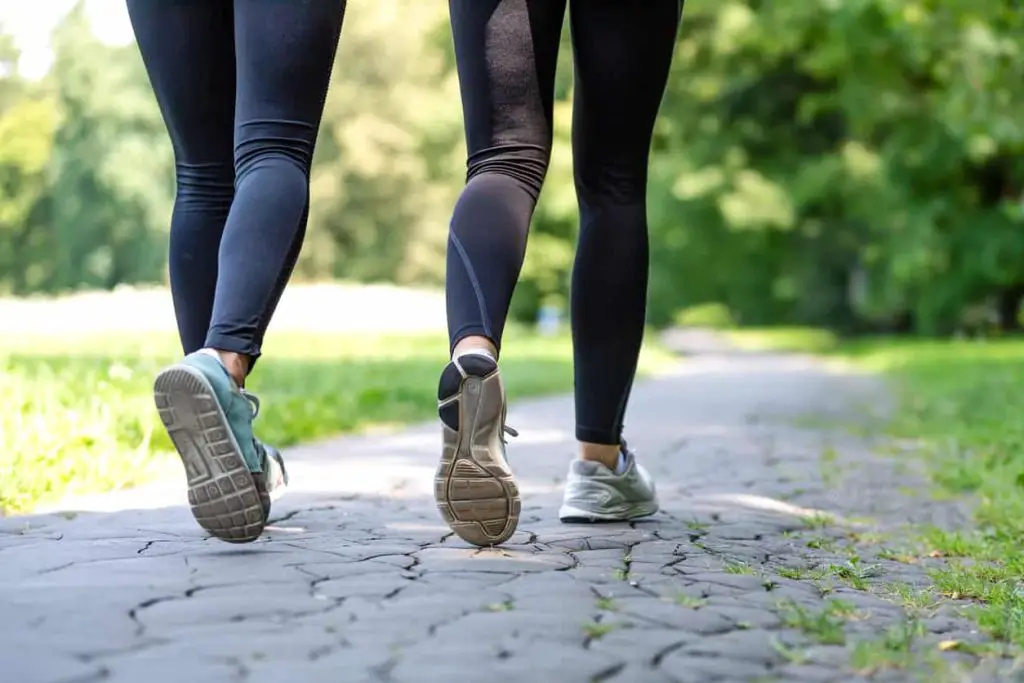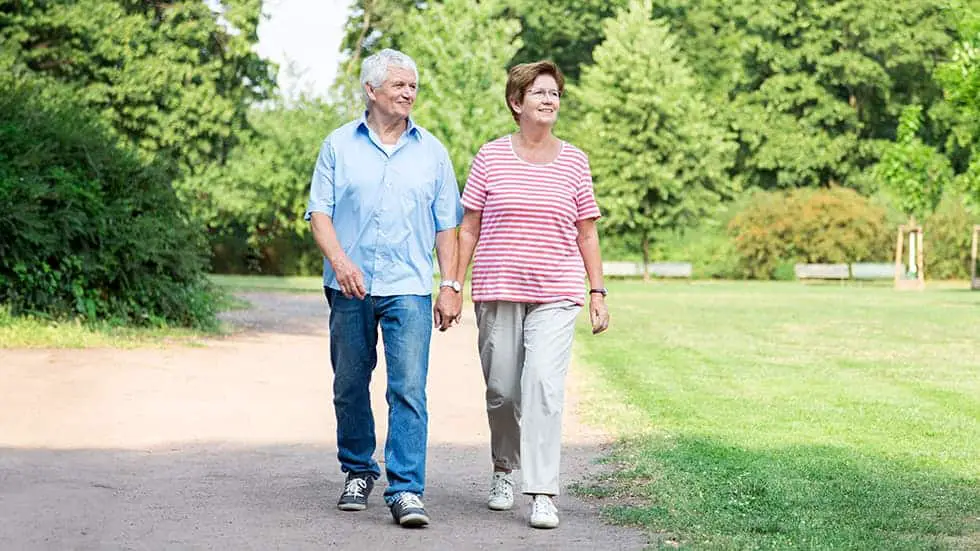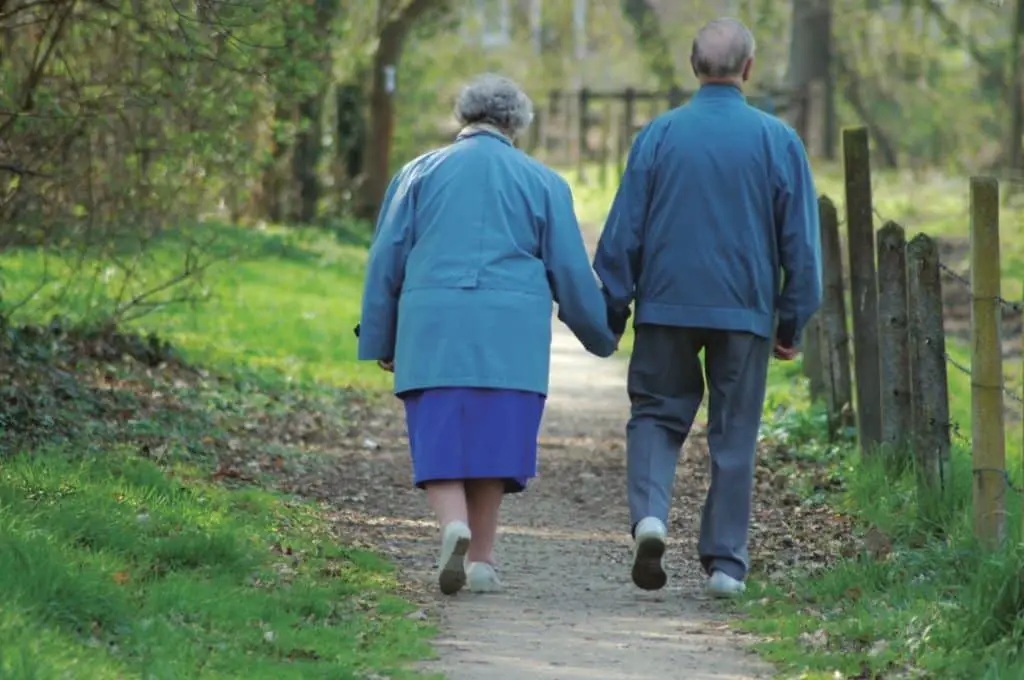Running requires a greater calorie expenditure than walking. walk for the same distance traveled. But this is on condition that the walking speed considered is “normal” (around 5 km/h).
Difference between running and walking
If we walk very slowly, it will take us so long to cover the 3 km that the caloric expenditure will be greater in the end. This is because the body expends a certain amount of energy per unit of time no matter what, no matter what activity is performed (known as “basal metabolism”).
Imagine watching someone running. Now carefully observe the vertical (up and down) movement of their pelvis and head. As you can see from the diagram below, when we run, the distance our body travels up and down is greater than when we walk.
To produce this vertical movement, the muscles of the lower limbs must generate more force, and this consumes more energy, but does not bring us closer to our destination.
So when you run, part of the energy you use is used to move your body upwards rather than forwards. The energy needed to cover those 3 km is therefore greater for running than for walking.
This difference between walking and running is not limited to what happens during the activity itself. In fact, any physical exercise causes a delayed energy expenditure, which is added to the expenditure during the activity.

With this in mind, running is once again the most energy-intensive exercise compared to walking. Immediately after running your 3km, the increased energy expenditure (compared to rest) lasts for several minutes, mainly due to the increase in body temperature and the replenishment of energy reserves. This additional expenditure after running is more than double that observed after walking, due to the difference in intensity between the two exercises.
The same is true if the walking speed is very high (over 8 km/h): running is more energy efficient. In this case, the coordination required to walk at such a speed means that we have to activate our muscles more, without being able to exploit the elasticity of our tendons, as in the case of running.
Furthermore, we have a very precise intuitive sense of the energy efficiency of a particular style of movement. If we are on a treadmill whose speed gradually increases, the point at which we spontaneously switch from walking to running coincides with the point at which it would become more energy-consuming to walk than to run.
In conclusion, due to the increased sway in the center of mass and the increased energy expenditure after exercise, running to work is more energy-intensive than walking the same distance. But remember, whether you choose to walk or run to work, the most important thing is that you are already saving energy.
Walking “Teabag Style” for a Few Minutes a Day Could Help Adults Meet Physical Activity Goals
According to a study published in B.M.J.adults could meet global physical activity goals by walking inefficiently for just a few minutes a day.
Over the past 20 years, global rates of physical inactivity have not decreased, despite campaigns to increase physical activity and improve cardiovascular fitness in adults.
The inefficient walking styles of Messrs. Teabag and Putey, played by John Cleese and Michael Palin in the 1971 Monty Python sketch Ministry of Silly Walks, have been shown to be more variable than normal walking, but their energy expenditure has never been measured.
To address this critical gap in research, a team of U.S. researchers decided to compare the energy expenditure of low-efficiency walking with high-efficiency walking. Their findings are based on data from 13 healthy adults (six women, seven men) ages 22 to 71 (average age 34) with no history of heart or lung disease and no known gait disorders.

Height and body weight were measured and each participant was shown a video of the Ministry of Silly Walks sketch before performing three walking trials, each lasting five minutes, on a 30-meter indoor course.
In the first trial, participants walked in their usual style at a freely chosen pace. For the next two trials, participants were asked to recreate, to the best of their ability, the walks of Mr. Teabag and Mr. Putey that they had seen in the video.
The distance traveled during the five-minute walks was used to calculate average speed. Oxygen uptake (mL/kg/min), energy expenditure (kcal/kg/min), and exercise intensity (MET), or the amount of calories burned per minute of physical activity, were also measured.
The researchers found that only the Teabag walk resulted in significantly greater energy expenditure, about 2.5 times higher than normal walking.
For men and women combined, oxygen uptake during normal walking was 11.3 mL/kg/min (or 3.2 METs), which was similar to that of the Putey walk (12.3 mL/kg/min, or 3.5 METs). However, the Teabag walk resulted in an oxygen uptake of 27.9 mL/kg/min, or 8 METs, which qualifies as vigorous-intensity exercise.
In terms of energy expenditure, replacing even one minute of normal walking with one minute of Teabag walking was associated with an increase in energy expenditure of 8 kcal/min for men and 5 kcal/min for women.

Researchers estimate that adults could achieve 75 minutes of vigorous, high-intensity physical activity per week by walking in the Teabag style, rather than their usual style, for about 11 min/day. And replacing their usual style steps with Teabag style steps for about 12-19 min/day would increase daily energy expenditure by about 100 kcal.
This amount of teabag-style walking would likely increase cardiorespiratory fitness, reduce mortality risk, and require no additional time commitment because it replaces the movements adults already do with energy-intensive physical activity, they add.
This is a small-sample experimental study, and the researchers acknowledge that some people, including those with disabilities, gait disorders, joint disease, or other health conditions, may not be able to perform the Putey or Teabag walks. “But they may be able to increase energy expenditure in their daily movements, with inefficiency as the goal,” they say.
They also noted that short bouts of physical activity, lasting one to two minutes, accumulated over time can produce cardiovascular benefits, so people may want to regularly engage in short bouts of inefficient walking, at times and places that are most convenient for them, including indoors.
“Our analysis of energy expended during different walking styles seeks to empower people to move their bodies in more energetic and hopefully joyful ways,” they write. “Efforts to increase cardiovascular fitness should embrace inclusiveness and inefficiency for all.”
Walking Extends Lifespan of Eighty-Year-Olds
An hour of walking a week is associated with greater longevity in people aged 85 and over, according to research presented at the ESC Congress.
Regardless of age, adults are recommended to do at least 150 minutes a week of moderate-intensity activity or 75 minutes a week of vigorous-intensity activity, or an equivalent combination. However, in adults, sedentary time tends to increase with age while the amount of physical activity decreases.
“Adults are less likely to meet activity recommendations as they get older,” said study author Dr. Moo-Nyun Jin of Inje University Sanggye Paik Hospital in Seoul, Republic of Korea. “Our study suggests that walking at least an hour each week is beneficial for people aged 85 and older. In simple terms, walking for 10 minutes each day.”

This study examined the association between walking and the risks of all-cause and cardiovascular mortality among adults aged 85 years and older. Researchers used information from the Korean National Health Insurance Service (NHIS) Senior Database. The study included 7,047 adults aged 85 years and older who underwent the Korean National Health Screening Program from 2009 to 2014.
Participants completed a leisure-time physical activity questionnaire that asked about the amount of time they spent each week doing slow walking, moderate-intensity activities such as cycling and brisk walking, and vigorous-intensity activities such as running.
The mean age of participants was 87 years, and 4,813 (68.3%) were women. Participants were classified into five groups based on the time they spent walking at a slow pace per week. Approximately 4,051 (57.5%) participants did not walk slowly, 597 (8.5%) walked less than one hour, 849 (12.0%) walked one to two hours, 610 (8.7%) walked two to three hours, and 940 (13.3%) walked more than three hours per week.
In the entire study population of 7,047 adults, 1,037 (14.7%) participants engaged in moderate-intensity physical activity and 773 (10.9%) engaged in vigorous-intensity physical activity. Only 538 participants (7.6%) met guideline recommendations for moderate- to vigorous-intensity physical activity. Of the 2,996 participants who walked at a slow pace each week, 999 (33%) also engaged in moderate- or vigorous-intensity physical activity.

The researchers analyzed associations between walking, all-cause mortality, and cardiovascular mortality after adjusting for energy expenditure in moderate- to vigorous-intensity physical activity. Compared with inactive individuals, those who walked at least 1 hour per week (i.e., the three highest walking categories) had 40% and 39% lower relative risks of all-cause and cardiovascular mortality, respectively.
Dr. Jin said: “Walking was associated with a lower likelihood of dying in older adults, regardless of whether they were engaging in moderate- to vigorous-intensity physical activity. Identifying the minimum amount of exercise that can benefit older adults is an important goal, as recommended activity levels can be difficult to achieve.
Our study indicates that walking just one hour a week is beneficial for people over 85 compared to being completely inactive. The take-home message is to continue walking throughout your life.”
#Walking #Running #Energy
